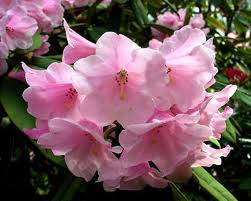Helianthus
These are hardy herbaceous perennials or annuals found wild in North America. They produce large yellow flowers in late summer and autumn. The perennial kinds are tall and vigorous. H. decapetalus multiflorus and its double variety, Soliel d'Or, grow 4 to 5 feet high. The prettiest one is called Monarch; it is a variety of H. atrorubens sparsifolius. This plant will grow 6 to 7 feet high and bear large, golden yellow blooms. All of the perennial kinds have yellow blossoms. H. argyrophyllus, the Silverleaf Sunflower is an annual kind that grows about 6 feet high. Its leaves are clothed with silky, soft hairs, which give them a distinctly silvery appearance. It produces many yellow flowers, 3 inches in diameter that have dark brown-purple centers. H. annuus is an annual commonly known as the Sunflower. It grows 6 to 10 feet high and produces huge, black centered flowers. There are varieties of the Sunflower with different colored flowers. Some are reddish, pale or deep yellow. The largest is the variety Russian Giant. The seeds of the Sunflower are rich in oil, the best kinds contain 28 or 30 percent. When cold pressed, this oil is useful as a salad oil, for cooking and for the manufacture of margarine. The seeds are also used for bird food for poultry and parrots and other caged birds. H. tuberosus, also known as the Sunchoke, Jerusalem Artichoke, or Girasole, is a hardy perennial grown for its edible tubers. As you can see, the Jersalem Artichoke is a relative of the Sunflower, not the Globe Artichoke (see, Cynara). This is a vigorous, enduring, versatile plant, which will grow up to 6 feet high in sunny, dry locations and much taller in fertile soil and partial shade. It produces yellow flowers with dark centers that are filled with small seeds, which birds love. They spread quickly and can become a nuisance. The Jerusalem Artichoke is usually grown in the far corner of the garden because they aren't very pretty looking. The texture of the tubers is much like early potatoes, but they have a slightly sweeter taste. They can be eaten raw or cooked like potatoes. The tubers contain insulin, a carbohydrate that diabetics can digest.
Pot Cultivation
Sunflowers will thrive in regular soil in a sunny or partially shaded position. Birds will begin stealing seeds 1 to 2 weeks before they are fully dry. To prevent this, wrap cheesecloth around the heads. Test the seed coats once in a while with your thumbnail. When they are hard, cut the stem about 6 inches below the flower and hang indoors to complete drying. Jerusalem Artichokes can grow in any soil, but one that is fertilized with manure and watered during dry spells is the best. In the autumn, the tubers may be lifted carefully and dried completely and stored in a cool, dry place. Make sure to sift through the soil thoroughly to prevent unwanted escapes.
Propagation
Sunflower seeds may be sown outside in full sun 1 to 2 weeks before the frost-free date. Seedlings will appear in a few days and will survive frost. Thin the giant varieties 3� to 4 feet apart. If they are spaced too close, they will form lanky plants with dwarf heads. In windy locations, tie stalks loosely to fence posts or some other support. The Jerusalem Artichoke may be increased by planting tubers 2 inches deep and 2 feet apart, in early spring or late summer.
 |
H. argyropyllus |
VARIETIES
- Sunflowers: Perennials -
H. decapetalus multiflorus & variety Soleil d'Or;
H. atrorubens sparsifolius & variety Monarch;
H. laetiflorus Miss Mellish;
H. decapetalus Capenoch Star; Loddon Gold;
H. salicifolius. Annuals -
H. annuus, the annual Sunflower;
H. argyropyllus;
H. debilis cucumerifolius; Stella; Primrose Stella; Dazzler; Excelsior; Orion.
- Jerusalem Artichoke -
H. tuberosus. Tubers can be ordered by mail or bought from health food stores or gourmet produce shops. The few named varieties are usually only available to commercial growers.





